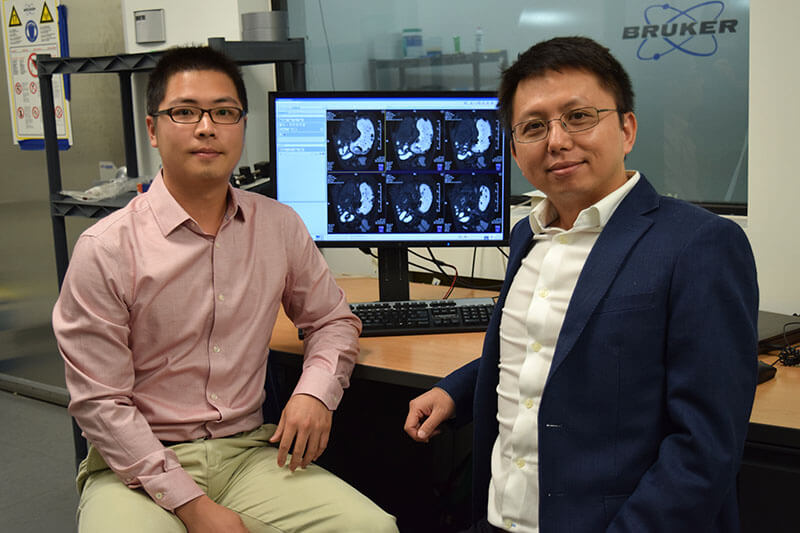एमआरआई उपकरण यह देखता है कि विद्युत उत्तेजना पाचन संबंधी विकारों को कैसे ठीक कर सकती है
से ज्यादा 60 लाख लोग अमेरिका में. जठरांत्र संबंधी विकारों से पीड़ित हैं जिन्हें विद्युत उत्तेजना से ठीक किया जा सकता है, लेकिन वैज्ञानिक किसी महत्वपूर्ण अंग पर थेरेपी के प्रभाव को पूरी तरह से नहीं समझते हैं: पेट. पर्ड्यू विश्वविद्यालय के शोधकर्ताओं ने एमआरआई का उपयोग करके यह दिखाया कि वेगस तंत्रिका में विद्युत उत्तेजना भेजने से पेट की जटिलताओं को सफलतापूर्वक कैसे ठीक किया जाता है।. यह तकनीक अधिक सटीक उपचार का मार्ग प्रशस्त करती है जिसे दवाओं और आहार परिवर्तन से हासिल नहीं किया जा सका है.
 एक नई एमआरआई तकनीक वैज्ञानिकों को यह समझने में मदद करती है कि पेट वेगस तंत्रिका उत्तेजना पर कैसे प्रतिक्रिया करता है, जो पाचन विकारों के लिए अधिक सटीक उपचार प्रदान कर सकता है. (पर्ड्यू विश्वविद्यालय वीडियो/कुन-हान लू) छवि डाउनलोड करें
एक नई एमआरआई तकनीक वैज्ञानिकों को यह समझने में मदद करती है कि पेट वेगस तंत्रिका उत्तेजना पर कैसे प्रतिक्रिया करता है, जो पाचन विकारों के लिए अधिक सटीक उपचार प्रदान कर सकता है. (पर्ड्यू विश्वविद्यालय वीडियो/कुन-हान लू) छवि डाउनलोड करें“अंततः, एक मरीज को विभिन्न विद्युत उत्तेजना सेटिंग्स के साथ कई एमआरआई स्कैन से गुजरने के लिए कहकर, हम उस विशेष रोगी के लक्षणों को कम करने के लिए सर्वोत्तम उत्तेजना सेटिंग का पता लगा सकते हैं,” कुन-हान ने कहा “टॉम” लू, एक पीएच.डी. में छात्र इलेक्ट्रिकल और कंप्यूटर इंजीनियरिंग.
काम, जिसे जर्नल के कवर के रूप में प्रकाशित किया गया है न्यूरोगैस्ट्रोएंटरोलॉजी और गतिशीलता इसके अक्टूबर में 2018 मुद्दा, पर्ड्यू के साथ संरेखित होता है विशालकाय छलांग उत्सव, स्वास्थ्य के क्षेत्र में विश्वविद्यालय की वैश्विक प्रगति को स्वीकार करते हुए, पर्ड्यू की 150वीं वर्षगांठ के हिस्से के रूप में दीर्घायु और जीवन की गुणवत्ता. यह साल भर चलने वाले उत्सव के चार विषयों में से एक है विचार महोत्सव, वास्तविक दुनिया के मुद्दों को हल करने वाले बौद्धिक केंद्र के रूप में पर्ड्यू को प्रदर्शित करने के लिए डिज़ाइन किया गया.
पाचन संबंधी विकार एक चिकित्सीय बोझ पैदा करते हैं हर साल अरबों डॉलर.
पाचन विकार का एक महत्वपूर्ण संकेतक वह दर है जिस पर पेट भोजन से खाली हो जाता है, बुलाया “खाली पेट,” पोषक तत्वों के अवशोषण के लिए छोटी आंत में. गैस्ट्रोपेरेसिस विकार में गैस्ट्रिक का धीमी गति से खाली होना, उदाहरण के लिए, इसका मतलब है कि पेट की मांसपेशियां ठीक से नहीं चल रही हैं.
वेगस तंत्रिका को उत्तेजित करने से डॉक्टरों को यह नियंत्रित करने में मदद मिलेगी कि पेट कितनी तेजी से खाली होता है, गैस्ट्रोपेरसिस को प्रभावी ढंग से ठीक करना.
“मनुष्यों में पेट के लिए कुछ उत्तेजना प्रोटोकॉल को पहले से ही FDA अनुमोदन प्राप्त है, लेकिन वे केवल आंशिक रूप से ही प्रभावी साबित हुए हैं,” कहा टेरी पॉवले, पर्ड्यू के प्रतिष्ठित प्रोफेसर तंत्रिका विज्ञान और के निदेशक स्पार्क (स्थितियों से राहत पाने के लिए परिधीय गतिविधि को उत्तेजित करना) परियोजना, पेट की तंत्रिका सर्किटरी का पता लगाने के लिए राष्ट्रीय स्वास्थ्य संस्थान की एक पहल.
 पर्ड्यू विश्वविद्यालय के शोधकर्ता कुन-हान लू (बाएं) और झोंगमिंग लियू (अधिकार) बेहतर उपचारों की जानकारी देने के लिए पेट की कार्यप्रणाली का वास्तविक समय पर मूल्यांकन प्रदान कर रहे हैं. छवि डाउनलोड करें
पर्ड्यू विश्वविद्यालय के शोधकर्ता कुन-हान लू (बाएं) और झोंगमिंग लियू (अधिकार) बेहतर उपचारों की जानकारी देने के लिए पेट की कार्यप्रणाली का वास्तविक समय पर मूल्यांकन प्रदान कर रहे हैं. छवि डाउनलोड करें
SPARC परियोजना के भाग के रूप में, पर्ड्यू शोधकर्ताओं ने पेट पर वेगस तंत्रिका उत्तेजना के प्रभावों को बेहतर ढंग से देखने के लिए छोटे जानवरों में एमआरआई का उपयोग करने का प्रस्ताव रखा.
“एमआरआई गैर-आक्रामक हैं, ऊतक कंट्रास्ट को अच्छी तरह से दिखाएं और सत्यापन के लिए एक प्रयोग को दोहराना आसान बनाएं,” लू ने कहा. एक यूट्यूब वीडियो यहां उपलब्ध है https://youtu.be/ewsx0g2suSE.
लू ने चूहों में पाइलोरिक स्फिंक्टर को नियंत्रित करने के लिए वेगस तंत्रिका को उत्तेजित किया, वह वाल्व जो पेट से निकलकर छोटी आंत में प्रवेश करने वाले भोजन को नियंत्रित करता है. फिर उन्होंने समय के साथ एमआरआई छवियों का 3डी पुनर्निर्माण बनाया. छवियों से पता चला कि उत्तेजना ने पाइलोरिक स्फिंक्टर को आराम दिया, गैस्ट्रोपेरेसिस के मामले में विलंबित खाली करने को संभावित रूप से ठीक करने के लिए गैस्ट्रिक खाली करने में तेजी लाना, या अन्य प्रकार की गैस्ट्रोइंटेस्टाइनल खराबी.
“यह विधि किसी भी उपचार के प्रभावों को समझने के लिए शारीरिक जानकारी प्रदान करती है ताकि इसे किसी विशिष्ट अंग या विशिष्ट विकार के लिए ठीक किया जा सके।,” कहा झोंगमिंग लियू, के सहायक प्रोफेसर जैवचिकित्सा अभियांत्रिकी और इलेक्ट्रिकल और कंप्यूटर इंजीनियरिंग.
शोधकर्ताओं ने गैस्ट्रिक फिजियोलॉजी के बारे में और भी अधिक जानकारी प्राप्त करने और गैस्ट्रिक विकारों पर विभिन्न उपचारों के अपने स्वयं के परीक्षण करने के लिए प्रौद्योगिकी को आगे बढ़ाने की योजना बनाई है।.
स्रोत: www.purdue.edu, कायला विल्स द्वारा


उत्तर छोड़ दें
आपको चाहिए लॉग इन करें या रजिस्टर करें एक नई टिप्पणी जोड़ने के लिए .